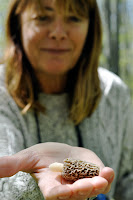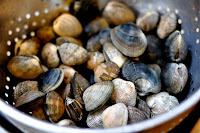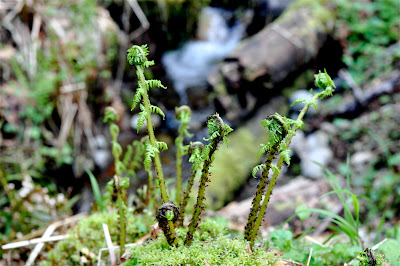To hear five-time national morel hunting champion Tony Williams tell it, the bold idea of calling Boyne City, Michigan’s, tribute to everything Morchella a national festival was easy. No one else had one. Certainly not 51 years ago when it was first hatched.

The hunting contest itself was born in a bar. “Guys were arguing,”explained Tony (pictured with the rustic furniture he builds). “It was a bar fight! A group of about twenty met in the morning to settle it. One of them was a Lion’s Club member. They said, ‘We should organize this for the city. Nobody else is doing it, so let’s call it the National Morel Mushroom Festival.’”
A half century later, the National Morel Mushroom Festival attracts aficionados, fanatics, and the merely curious to Lake Charlevoix’s scenic shore to learn about morels, eat them in quantity, and even—should they be so inclined—purchase a few giant chain-saw replicas to decorate the front lawn.
This is bucolic country, a photogenic trip back to an older, more innocent America, with rolling hills of leafy hardwoods, neat geometric agricultural plots, and farm houses dotting the countryside. The city itself is a small if fairly bustling burg of restaurants, galleries, and shops, a place that does much of its business in the summertime—with a head start in mid-May thanks to the morel fest.
I’ve been following the festival from afar for a number of years now, and finding myself in the northern woods of Michigan this May to visit friends in Marquette, I just had to make the four-hour trip downstate—as the Yoopers would say—to check it out. I was also hoping to see the sort of morels that are typical in the Midwest but less common where I live.
Like the Pacific Northwest, midwestern morel hunters find natural black morels, which are usually the first true morels to flush in the Great Lakes region each spring. But after the blacks fruit they also find a confusing variety of species commonly called grays, whites, and yellows. Some of these might be the same species at different stages of growth; others look suspiciously similar to what we sometimes call Morchella esculenta.

So I entered the contest and boarded a yellow school bus on a drizzly Saturday morning. What better way to see for myself? With a flashing police escort, we drove out of town to a predetermined secret spot a half-hour away near Chandler Hill. Each contestant signed a clip board so the bus driver could count heads on the way back. “Two or three people got lost in the woods last year,” someone in the front said. On our bus we had morel hunters from Indiana, Wisconsin, Ohio, and even North Carolina. On another bus there was a couple of South Korean women and a mycologist from the Mediterranean island of Cyprus.
I happened to be seated next to a local writer, Mary Ellen Geist, author of Measure of the Heart. Mary Ellen warned me that I better be ready to hit the woods at a full gallop because these hunters were serious. Sure, sure, I said. I’ll be ready. My main concern was getting some photos of the action.
With that in mind I tried to identify likely experts—camo clothing, trucker hats, and a sneaking caginess were all part of my criteria—to follow into the woods for a photo-op. But then, moments after stepping off the bus, a bullhorn siren blared and everyone took off in a mad, cutthroat dash for the woods. I was still fiddling with the settings on my camera! Even Mary Ellen, who I figured could be my guide in a pinch, was last seen high-stepping through raspberry brambles on her way out of sight.
I wandered into the forest nearly last, fumbling with the camera and realizing I’d left my compass behind.
First impressions? I was a long way from Cle Elum. These great northern woods aren’t like the east slope of the Cascades. Where’s the topography? I wondered. How do you pick out landmarks? Without a map and compass I was feeling uncertain about my ability to roam at will. I found some kids and stuck close by, snapping pictures. They were in their mid-teens, from Ontario, and had been allowed to hunt by themselves for the first time this year. “My dad was champion a few years ago,” one of them bragged. They weren’t really sure where they were. “If we get lost dad’s gonna kill us.”
As any mushroom hunter knows, morels don’t obey the laws of human commerce. This year they were late. The assembled hunters pulled mostly “caps” from the underbrush, the related Verpa bohemica mushrooms (pictured) that look somewhat like morels. Caps are fair game in the contest even if most people don’t eat them, and good thing—otherwise most of the contestants would have scored a big goose egg, including me.

Knowing your trees is an important part of morel hunting wherever you are, but especially in the Midwest. Old apple trees, dying or dead elms, and ash trees are good producers. In Northern Michigan the ashes seemed to be the ticket, and I spoke with many experienced hunters who said they’ll pick out ash trees from afar and walk—or in the the case of the contest, run—directly toward them. The older the ash the better, with clusters of them being even better yet. Notice the diamond-like patterning of the ash bark at right. Tony Williams can pick out ash trees by the lime-green color of their new leaves from miles away.
This year’s contest winner ended up picking something like 342 mushrooms in 90 minutes, of which only 40 or 50 were true morels. The record is held by Tony, with nearly 800 mushrooms picked during two consecutive 90-minute contests in the mid-eighties.
Like almost everyone else in the the hunt, yours truly didn’t find a single true morel, just caps. Per usual when I travel, my timing was just a bit off, like maybe 48 hours off. More about that in a moment. After boarding the buses and returning to town, the next eagerly anticipated event was the Taste of Morels, in which local restaurants cook up a bite to eat and compete for top honors. My personal favorites (though I didn’t get to taste everything) were Red Mesa Grill’s Corn Cakes with Morel Cream Sauce, which placed third, and Cafe Sante’s Duck Onion Soup with Morel Duxelles, which took first.

All this morel action was starting to gnaw at me. Was I really going to leave Michigan without finding my own? On my way out of town the next morning I got a call from Mary Ellen. Just that morning she had taken a stroll near her home and found the first “grays” of the season. “Get over here quick!” she advised. Well, I suppose I could be a little late for dinner back in Marquette… Sure enough, a few little morels were just starting to pop around an old apple tree in an overgrown orchard. She held one out for inspection. Whether it was a gray, white, or yellow—or all three—I couldn’t be sure, but it definitely had the fetching demeanor of a true morel and I could feel the first twinges of a sickness coming on.
“I’ve got another spot we need to check,” said Mary Ellen. We hurried back to our cars and drove down the road a piece, pulling off on a dirt track a mile or so away. We both had the fever now. Ramps of perfect harvesting size carpeted the ground and Dutchman’s breeches bloomed in delicate bunches.
“How will we ever see them with this riot of greenery?”
“Look for the ash.”
My eye was getting better. I picked out a cluster of three ash trees and then started poking around. Voila! A small morel tried to hide from me beneath a trillium. And another… Soon I had a dozen from this one cluster of ash trees. We spotted another large ash and made a bee-line. More morels. I was scoring the way the locals did. An hour later, with enough morels to bring to Marquette, I thanked Mary Ellen and reluctantly bid adieu to Boyne City.

That night my old friends Russ and Carol put together a feast of homemade pasta with Lamb and Morel Stew ladled on top and spring asparagus on the side. Local, seasonal, and superb. We walked it off on the beach a few blocks from their home, Lake Superior lapping in the moonlight, and finished the evening with a couple beers at a hotel bar in town. The next day I would be leaving—but not without a fistful of that other local delicacy, ramps…
Like this:
Like Loading...
























































